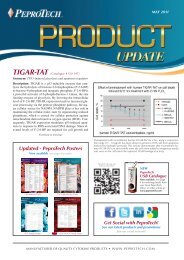PEPROTECH ®www.peprotech.comMicroarrayMicroarray technology enables the simultaneousdetection and quantification of a large number ofproteins or nucleic acids in a variety of biologicalsamples, including cells, tissues, and bodily fluids. Theterm microarray refers to a miniaturized solid supportor chip, such as a nylon membrane or glass microscopeslide, which is spotted with a capture element (antibody,protein, oligonucleotide, cDNA, etc.) in a grid-like configuration.There are many applications of microarraysincluding assessing protein families, probing serum fordiagnostic information, profiling expression in responseto drugs, and profiling cells treated with certain stimulatorsor transfected with a given gene. Although thereare many procedural variations, the five essential stepsin the preparation of a microarray are: 1) capture elementsynthesis, 2) preparation of the solid support surface,3) immobilization of the capture elements ontothe solid support (using a robotic arrayer), 4) bindingof the target molecule to the immobilized capture elements,and 5) detection and quantification of the target/captureelement complex.Antibody microarrays use antibodies, raisedagainst known protein antigens, as the capture elementsand proteins capable of specifically binding to the immobilizedantibodies as the detected target molecules.Fluorescent dyes such as Cy3, Cy5, FITC, and TexasRed, or enzyme systems such as biotin-horseradish peroxidase,are a sensitive means of detection and visualization.Antibody microarrays exploit many of the sameprinciples applied to well established immunoassayprocedures such as ELISA or Western blot; however,microarrays offer many advantages including an increasednumber of data points (which has a direct effecton accuracy), the ability to detect many proteinssimultaneously, and reduced antibody and sample volumerequirements. In addition, once an array hasbeen designed and the components validated, a roboticarrayer can rapidly spot limitless copies for use withlarge sample groups.In this article, two antibody microarray formatswill be highlighted: direct labeling and fluorescence-linkedimmunosorbent assay (FLISA). Both assaysuse specific antibodies as the capture element. Indirect labeling, all proteins in the sample mixture arelabeled prior to capture in contrast to FLISA, wheretarget proteins from an untreated sample mixture arecaptured and subsequently detected through the use ofa biotinylated antibody and a fluorophore-labeled secondaryantibody.Antibodies used in microarray assays workbest when they are highly purified, exhibit minimalcross-reactivity, and have been shown to work well intraditional ELISA formats. Initially, antibody solutionsare prepared at a pre-determined optimal concentration(usually 300-500µg/ml), and then they are assembledinto a print plate or microtiter plate, which is used by arobotic arrayer to prepare a spotted solid support. Sixto ten replicates per antibody are usually sufficient and,depending on the researcher’s needs, up to 500 differentantibodies per array can be spotted and immobilizedfor comparison. The spotted support is blockedby treatment with a BSA solution for at least one hour,and then, the support is ready to be exposed to thesamples of interest (serum, urine, cell lysate, etc).Figure 1 depicts direct labeling detection. Allproteins in a complex mixture are conjugated to eithera fluorophore (Figure 1A) or biotin prior to incubationwith the capture element. The arrays are thenwashed and scanned for data analysis. The comparisonof signal intensities between samples can be usedto measure the relative amounts or expression levels ofdetected proteins. Alternatively, the comparison of signalintensities to calibrated protein standards, labeledwith distinct fluorphores, allows exact expression lev-INFORMATION & TECHNICAL SUPPORTBestellungen: Deutschland: Tel: 0800 436 99 10 • email: info@peprotech.dePour commander: France: Tel: +33 (0)1 46 24 58 20 • email: info@peprotechfr.comTo Order: NORDIC: Tel: +46 (0)8 640 41 07 • email: info@peprotech.se177
www.peprotech.com<strong>2011</strong>-<strong>2012</strong> <strong>Catalogue</strong>Microarray ContinuedINFORMATION & TECHNICAL SUPPORTels to be quantitatively measured (Figure 1B). Advantagesof this method are its simplicity and the requirementof only one specific antibody per target. The primarydisadvantage is increased background signal resultingfrom the labeling of all proteins in the samplemixture (e.g. albumin in serum). Detection sensitivityis limited by the concentration of the background proteinrelative to the target protein and is typically around100ng/ml in serum.In FLISA detection (Figure 2), antibodiesspotted on the microarray capture unlabeled proteintar-gets. This is followed by incubation with a cocktailof biotin-labeled antibodies, each antibody correspondingto one of the spotted capture antibodies. Finally, thearray is incubated with a suitable detection antibodysuch as a fluorophore labeled anti-biotin secondary antibody.The FLISA detection format results in increasedsensitivity, relative to the direct labeling method, becausebackground is significantly reduced. Sensitivity in thisformat can be enhanced even further using tyramide signalamplification or rolling-circle amplification (3).However, optimization of assays measuring many targetscan be difficult using this format; therefore, FLISAdetection is usually used for a limited number of targetsthat are present at concentrations below the detection limitof the direct labeling method. Although the detectionlimits for the assay depends on a number of parameters,including the affinity and specificity of the antibodiesused, the protein background in the sample, and the detectionconditions chosen, the FLISA method can providedetection limits in the low pg/ml range.References:(1) Fung, Eric ed. Protein arrays: methods and protocols. Fremont,CA: Humana Press <strong>Inc</strong>.; 2004.(2) Ye, S. and Day, I. eds. et al. Microarrays and Microplates:applications in biomedical sciences. Oxford, UK: BIOSScientific Publishers Ltd.; 2003.(3) Zhou, Heping, et al. Genome Biology, Vol. 5, issue 4, R28; 2004.178To Order: EC: Tel: +44 (0)20 7610 3062 • email: info@peprotech.co.ukBestellungen: AUSTRIA: Tel: +43 (0)1 405 9696 • email: info@peprotech.atObjednávky: Česká Rep.: Tel: +420 225 992 284 • email: info@peprotech.cz





